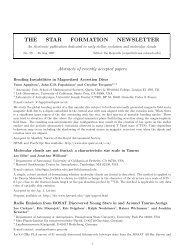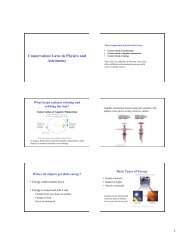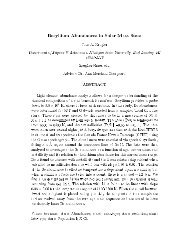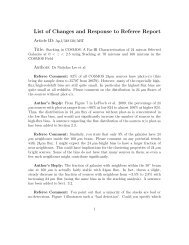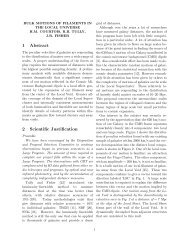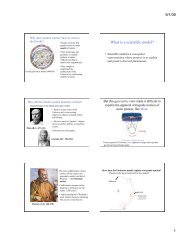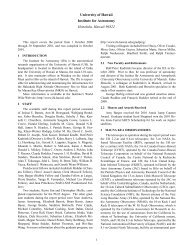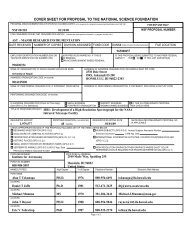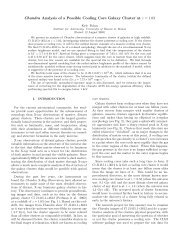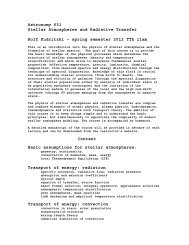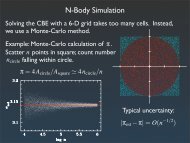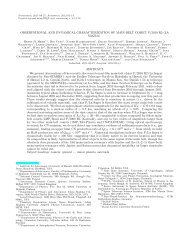The Pan-STARRS1 Photometric System
The Pan-STARRS1 Photometric System
The Pan-STARRS1 Photometric System
You also want an ePaper? Increase the reach of your titles
YUMPU automatically turns print PDFs into web optimized ePapers that Google loves.
PS Seminar 120907
Orthogonal Transfer Image Correction<br />
• Orthogonal Transfer CCD<br />
– Pixel design which can<br />
noiselessly remove image<br />
motion at high speed<br />
Pixel<br />
structure<br />
Independently<br />
Addressable Cell<br />
OTA:<br />
8x8 Array of Cells<br />
PS Seminar 120907<br />
2
Orthogonal Transfer Arrays<br />
• Orthogonal Transfer Array: A<br />
new pixel/CCD chip design to<br />
noiselessly remove image motion<br />
at high speed (~10 usec)<br />
• Current use on PS1 to<br />
simulaneously track stars and<br />
multiple GEO satellites<br />
Normal guiding (0.73”) OT tracking (0.50”)<br />
PS Seminar 120907
<strong>Pan</strong>-STARRS Gigapixel Camera<br />
PS Seminar 120907<br />
4
17-Jul-2007<br />
PS Seminar 120907
PS Seminar 120907<br />
6<br />
13-Aug-2007
PS Seminar 120907<br />
7
PS Seminar 120907
<strong>Pan</strong>-STARRS Photometry<br />
• <strong>The</strong> AB magnitude system<br />
– Defined as a monochromatic flux density:<br />
m AB = 0 at 3631 Jy = 3631 x 10 -26 W/m 2 /Hz<br />
– Over a bandpass, AB magnitude is defined as the ratio of a<br />
detector’s response to an SED relative to its response to<br />
3631 Jy.<br />
– Defined to match the Vega system (boo, hiss) at 548 nm<br />
• Three main issues:<br />
– What are the <strong>Pan</strong>-STARRS bandpasses? (Cal screen)<br />
– What is the zeropoint on the AB system for all these stars?<br />
(HST spectrophotometric standard stars)<br />
– What is the relative photometry in the <strong>Pan</strong>-STARRS<br />
bandpasses of stars all around the sky? (Uber-calibration.)<br />
PS Seminar 120907
Calibration Screen<br />
(Chris Stubbs, John Tonry, Keith Lykke)<br />
• Illuminate a screen with monochromatic<br />
light<br />
from NIST laser that can be tuned over<br />
the<br />
entire 400nm-1020nm wavelength range of<br />
PS1<br />
• Measure the system throughput as a<br />
function of wavelength for every pixel.<br />
• Monitor system throughput with white<br />
light flats.<br />
• Also use a projection telescope to put a<br />
beam through the optics that avoids all<br />
scatterers.<br />
PS Seminar 120907
Spectroscopic Sky Probe<br />
• 14cm telescope with a<br />
diffraction grating over the<br />
aperture that takes<br />
pictures of Polaris every<br />
30 sec.<br />
• Useful for determining<br />
water content of the<br />
atmosphere (now), and<br />
aerosol content<br />
(someday).<br />
PS Seminar 120907
Bandpasses<br />
• Components to the <strong>Pan</strong>-STARRS zeropoint<br />
– Aperture (1.8m diameter)<br />
– Atmosphere (0.9)<br />
– Vignetting (0.62)<br />
– Mirror losses (0.8)<br />
– AR coating losses (0.9)<br />
– Dirt (0.9)<br />
– Filter transmission (0.9 and bandpass)<br />
– Detector QE (0.5-0.9)<br />
• ~70% of photons on 1.8m diameter are lost!<br />
PS Seminar 120907
Avoid Stray Light!<br />
• Avoid scattered light by using a<br />
projection telescope<br />
• Avoid ghosts by measuring<br />
them and subtracting<br />
PS Seminar 120907
Filter Transmission<br />
• Filter transmission depends on radius (a lot)<br />
• Manufacturer’s (Barr) curves seem accurate.<br />
PS Seminar 120907
Filter Transmission for f/4.4 Beam<br />
• <strong>The</strong> Barr (and projection<br />
telescope) measurements<br />
were done in nearly<br />
parallel light. <strong>Pan</strong>-<br />
STARRS has an f/4.4<br />
beam, spread over a 4”<br />
diameter on filters.<br />
• Ray-trace and use a fit to<br />
interference filter<br />
transmission as a function<br />
of angle of incidence to get<br />
the final filter transmission<br />
function.<br />
PS Seminar 120907
CCD QE<br />
Red QE as a function of temperature<br />
Blue QE<br />
depends on AR<br />
coating<br />
PS Seminar 120907
Components of <strong>System</strong> Throughput<br />
PS Seminar 120907
Atmospheric extinction<br />
Atmosphere<br />
Modtran and Polaris<br />
Extinction as a fn of airmass One month PS of Seminar water 120907
Spectrophotometric Standards<br />
• Eight HST “Calspec”<br />
spectrophotometric<br />
standards<br />
• AB compliance largely<br />
from models of dA WD<br />
• Accuracy<br />
2% very likely<br />
1% some stars, some<br />
wavelengths<br />
Lots and lots of<br />
spectrophotometric<br />
standards, integrated<br />
against PS1 bandpasses<br />
Stellar Locus<br />
Observed stellar<br />
colors in one of the<br />
Calspec standard star<br />
fields<br />
PS Seminar 120907
SDSS Comparison<br />
SDSS (we believe) has ~0.02 mag errors<br />
PS Seminar 120907
PS1 Effective Area<br />
<strong>The</strong> <strong>Pan</strong>-<strong>STARRS1</strong> <strong>Photometric</strong> <strong>System</strong><br />
Tonry et al. 2012, ApJ 750, 99<br />
PS Seminar 120907
MD Observations<br />
PS Seminar 120907
JT MD Ongoing Projects<br />
• Partners: Flewelling, Heasley<br />
• Papers and work underway<br />
– Supernova templates and photometry (Scolnic, Rodney,<br />
Rest, Huber, Foley, …)<br />
– SNIa host galaxies (Tonry, Rodney)<br />
– <strong>Photometric</strong> redshifts (Saglia)<br />
– PS white dwarfs (Tonry)<br />
– Variable stars (Flewelling)<br />
– Brown dwarfs (Aller, Liu)<br />
– Weak lensing (Dixon, Kaiser)<br />
– QSO variability (Suh, Hasinger)<br />
– Various TOO (e.g. Gezari)<br />
PS Seminar 120907
SNIa Hosts (Huber)<br />
• Large range in host properties!<br />
PS Seminar 120907
Objects in MD Fields<br />
PS Seminar 120907<br />
0.5M bright stars 10M all objects
MD proper motion: high µ<br />
• PS1 astrometric residuals ~25mas<br />
• Baseline 2 years and growing, USNO-B, SDSS, or<br />
2MASS can provide a first epoch for bright m<br />
• ~4800 proper motions >6 sigma, >40mas/yr<br />
(Known) m=18<br />
WD moving at<br />
1.8”/yr<br />
PS Seminar 120907
Reduced proper motion<br />
• ~65,000 proper motions at 3σ<br />
4,800 objects, 6σ<br />
PS Seminar 120907
Brown Dwarfs (Aller)<br />
• Extremely fast, faint, red star<br />
– 711 mas/yr<br />
– g
MD proper motions: white dwarf<br />
• Binary white dwarf<br />
– 366 mas/yr, Hr=21.97<br />
– g=19.74 19.74<br />
– r=19.13 19.18<br />
– i =18.54 18.64<br />
– z=18.71 18.81<br />
– (g-r)=0.59, (r-i)=0.56<br />
– ~30pc? 5.4” separation ~150AU<br />
POSS-II F<br />
PS Seminar 120907
White Dwarf Planets<br />
• Eric Agol has suggested that WD planets might host life<br />
– Duration of eclipse: ~2 min<br />
– Probability of habitable planet’s orbit causing eclipse: 0.01<br />
– Probability of being in eclipse in any 2 min interval: 0.001<br />
• Search MD observations of WD for planetary eclipses<br />
– 3215 WD chosen by PM or color: 7738995 observations<br />
– OK data: 4635187 observations<br />
– IPP magnitude error < 0.2 mag: 4355900 observations<br />
– Drop by >4σ only once: 374 candidates<br />
– At least 20 pixels from CCD edge: 49 candidates<br />
– Delete flaws, patchy clouds, telescope moved: 0 planets<br />
• <strong>The</strong>refore frequency of habitable planets around WD is
High-z QSOs<br />
• Many point objects in MD fields with high accuracy,<br />
non-stellar colors<br />
• Variability and color selection<br />
PS Seminar 120907
z>6 QSO Searches (Suh)<br />
PS Seminar 120907
MD Field variables<br />
PS Seminar 120907
Variable Stars (Flewelling)<br />
PS Seminar 120907
Weak Lensing (Dixon)<br />
PS Seminar 120907
Asteroid Terrestrial-impact Last Alert <strong>System</strong><br />
(www.fallingstar.com)<br />
PS Seminar 120907
Survey Merit<br />
Point size proportional to<br />
solid angle surveyed<br />
within t cad<br />
Tonry 2011, PASP 123, 58<br />
PS Seminar 120907
Survey Merit<br />
Point size proportional to<br />
solid angle surveyed<br />
within t cad<br />
Tonry 2011, PASP 123, 58<br />
PS Seminar 120907
ATLAS Unit Telescope<br />
• Hardware (expect to build 2 units)<br />
– Houghton optics: 0.5m aperture,10°<br />
field of view<br />
– CCD: 100 Mpixel, 2.4” pixel camera,<br />
50 sq deg<br />
• Nominal observing plan<br />
– 30 sec exposure<br />
– r+i and g+r filter for two units<br />
– 5σ at AB=20 per exposure<br />
– 100,000 sq deg per night with two<br />
units. 4-5 visits to each point in the<br />
sky each night.<br />
– Same volume as PS1-MD or PTF2, but<br />
4 mag brighter…<br />
PS Seminar 120907
• Solar system<br />
ATLAS Science<br />
– ~10 3 NEO/yr, ~10 4 asteroid rotation, etc.<br />
• Stars<br />
– ~hr resolution light curve of all stars to m < 19<br />
• Planets: habitable planets<br />
– search WD for planetary transits, η Earth < 0.01<br />
• Gravitational lensing: dark matter, H 0<br />
– near field microlensing; AGN time delays<br />
• Supernovae: SN properties and large scale flows<br />
– ~10 4 SNIa/yr, many CCSN, ~10 bright ultraSN/yr<br />
• AGN and black holes: AGN properties and evolution<br />
– ~hr resolution of ~10 5 AGN to m



